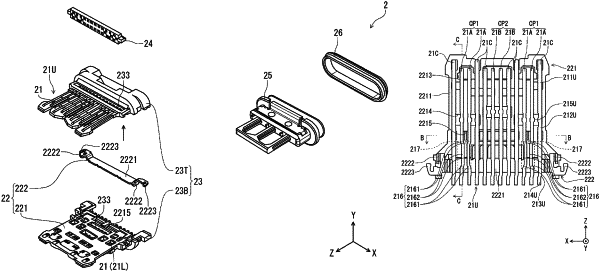| CPC H01R 13/6471 (2013.01) [H01R 13/5202 (2013.01); H01R 2107/00 (2013.01)] | 9 Claims |

|
1. An electrical connector which can engage with a corresponding connector inserted from a tip side thereof, comprising:
a first contact group constituted of a first plurality of contacts linearly extending along an insertion and extraction direction of the corresponding connector and arranged on a first contact plane;
a second contact group constituted of a second plurality of contacts linearly extending along the insertion and extraction direction of the corresponding connector and arranged on a second contact plane facing the first contact plane; and
a ground plate arranged on a ground plane facing the first contact plane and the second contact plane between the first contact plane and the second contact plane,
wherein each of the first contact group and the second contact group contains a signal contact pair for transmitting a differential signal,
wherein each of two contacts constituting the signal contact pair of each of the first contact group and the second contact group has a narrow pitch portion approaching from one of the two contacts toward another one of the two contacts,
wherein a separation distance between narrow pitch portions of the two contacts constituting the signal contact pairs of each of the first contact group and the second contact group is smaller than a separation distance between other portions of the two contacts, and
wherein the narrow pitch portion of each of the two contacts of the signal contact pair of the first contact group does not overlap with the narrow pitch portion of each of the two contacts of the signal contact pair of the second contact group in a planar view.
|